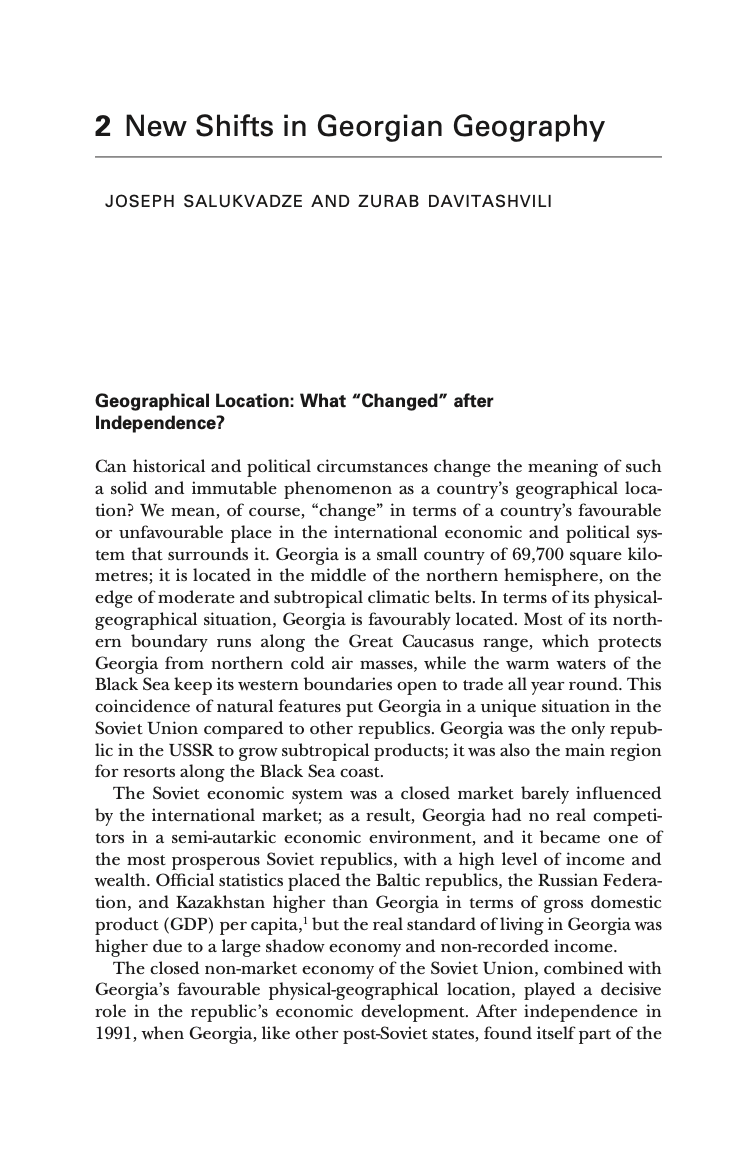Resource information
Can historical and political circumstances change the meaning of such a solid and immutable phenomenon as a country’s geographical location? We mean, of course, “change” in terms of a country’s favourable or unfavourable place in the international economic and political system that surrounds it. Georgia is a small country of 69,700 square kilometres; it is located in the middle of the northern hemisphere, on the edge of moderate and subtropical climatic belts. In terms of its physicalgeographical situation, Georgia is favourably located. Most of its northern boundary runs along the Great Caucasus range, which protects Georgia from northern cold air masses, while the warm waters of the Black Sea keep its western boundaries open to trade all year round. This coincidence of natural features put Georgia in a unique situation in the Soviet Union compared to other republics. Georgia was the only republic in the USSR to grow subtropical products; it was also the main region for resorts along the Black Sea coast. The Soviet economic system was a closed market barely influenced by the international market; as a result, Georgia had no real competitors in a semi-autarkic economic environment, and it became one of the most prosperous Soviet republics, with a high level of income and wealth. Official statistics placed the Baltic republics, the Russian Federation, and Kazakhstan higher than Georgia in terms of gross domestic product (GDP) per capita,1 but the real standard of living in Georgia was higher due to a large shadow economy and non-recorded income. The closed non-market economy of the Soviet Union, combined with Georgia’s favourable physical-geographical location, played a decisive role in the republic’s economic development. After independence in 1991, when Georgia, like other post-Soviet states, found itself part of the 2 New Shifts in Georgian Geography joseph salukvadze and zurab davitashvili New Shifts in Georgian Geography 39 international economy, these advantages disappeared. In the international market, the inefficient Soviet legacy in agriculture and tourism made Georgia’s produce uncompetitive compared with citrus fruits from Greece and Israel and its resorts uncompetitive compared with those in the Mediterranean. The loss of the Soviet market for Georgia’s goods and services hit the republic’s economy hard and the standard of living of its citizens plummeted. After independence in 1991, there were significant changes in the economic situation of Georgia. In the nineteenth and twentieth centuries, Georgia’s political and geographical situation was of little consequence. It could not be assessed independently or outside the context of the imperial state(s) of which it was a part. Georgia occupied a peripheral location, and it had limited transit connections to the centre during both empires, Russian and Soviet. The USSR developed Georgia’s transport infrastructure, but the republic remained a “dead-end space” with no accessibility to the outside world. In these conditions, Georgia’s location did not add significantly to its economic development. This situation changed dramatically after independence; the country became a focal point of east-west and north-south connections on an interregional scale. Today, Georgia’s transit and geographical situation is one of its major advantages. Georgia is at a crossroads that connects Central Asia with Europe on the one hand and with the Middle and Near East on the other. Georgia’s role as an energy corridor between east and west is significant; oil and gas pipelines carry energy supplies from Azerbaijan and Central Asia to Europe, bypassing Russia. The role of the BakuTbilisi-Kars railroad, which became operational in 2017, is one segment in the shortest rail route connecting China with Europe. In addition, Russia can maintain physical contact with Armenia, its major ally in the South Caucasus, only by using communication routes across Georgia’s territory. Finally, Georgia is the only country in the South Caucasus and Central Asia that enjoys direct access to the open sea. For eight countries – Azerbaijan, Armenia, Turkmenistan, Kazakhstan, Uzbekistan, Kyrgyzstan, Tajikistan, and Afghanistan – Georgia’s ports are a maritime gateway to the eastern Mediterranean and western markets.

